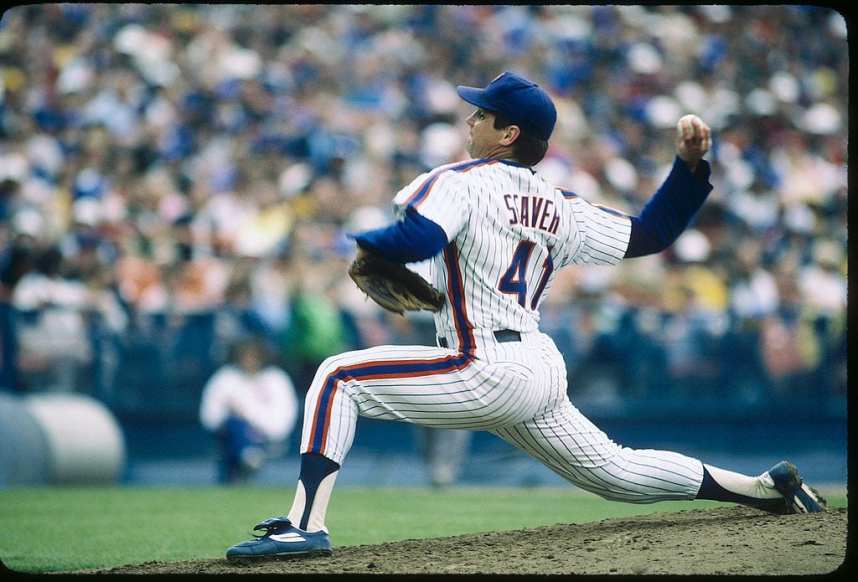
1969 was the greatest year in the history of New York Sports, hands down. The New York Jets, led by their megastar quarterback Joe Namath, did the impossible by upsetting the 19-point favorite Baltimore Colts in Super Bowl III. Later that year, the Knicks, buoyed by such stars as Willis Reed, Walt Frazier, Bill Bradley and Dave DeBusschere, would become the NBA champions, defeating the Los Angeles Lakers won sported Wilt Chamberlain, Jerry West and Elgin Baylor.
But it was the summer in-between those two great accomplishments that stirred the imagination of New Yorkers – and the sports world. The New York Mets, the worst franchise in baseball since their inception seven years prior, rose up and shocked the world by winning the 1969 World Series.
Led by the steady hand of manager Gil Hodges, the former Brooklyn Dodger great, and a kid out of Fresno – who the Mets won the rights to in a coin toss – named George Thomas Seaver.
As one of the only writers on this (or any other) website to witness Seaver’s career from beginning to end, I will attest that he was every bit as great as his numbers. In fact, he was even better.
Seaver won three Cy Young Awards, all for the Mets, but should have won six. In 1969, there was no better pitcher in the game. Strike that, there was no better star in the game. In New York, Seaver became a god.
I was in third grade in a parochial school in Flushing in 1969. We were Met crazy. We even named some of our classroom pets after Met players. The Mets were the talk of the town. In my house, we were all Met fans by virtue of my father having been a New York Giants fan who adopted the Mets when they formed in 1962. Like most ex-Giant and Dodger fans who didn’t follow those teams out to the coast, there was no way they were ever going to root for the Yankees, so they all became Met fans.
The first seven years were hell, but the Met fans decided they would stick with their team. They outdrew he Yankees consistently during that time. Little did they know how quickly the worm would turn for them. The losing ended overnight with each Seaver rising fastball and diving slider.
Seaver was the linchpin of the Mets’ success. Upon his arrival in 1967, the Mets finally had a legitimate star of their own to hang their hats on. When he pitched, the Mets were contenders no matter who they played. The top teams would come to Shea and Seaver would shut them all down: Mays, Aaron, McCovey, Stargell, Clemente, Rose, Bench etc. We loved it.
Hodges, along with general manager Johnny Murphy, saw this and built around it. In 1968, the Mets added a lefty compliment to Seaver in Jerry Koosman. Throw in some hungry players that Hodges got the most out of and the Mets were suddenly a factor in the National League.
Getting back to Seaver, no player since perhaps Babe Ruth or Joe DiMaggio had amassed such admiration and reverence from New York fans. He was a drawing card, hence the nickname “The Franchise” and he should have been a Met forever.
I was at the game when Seaver struck out the final 10 batters against the San Diego Padres. He was untouchable. He was so good, he spoiled Met fans. Imagine that! The fans of the worst perfuming franchise in sports history being spoiled! Only a player like Seaver could pull that off.
The 1977 trade of Seaver to Cincinnati for four young players was disgrace. The Mets’ brass didn’t see the changing financial landscape and dealt him away. With that, they squandered the best thing they ever had and let the biggest star in the history of the franchise – to this day – walk out the door. Over money, no less.
I recall 1969 vividly. As an eight-year-old sports nut, Seaver was as big as stars get. He was the fan eof the miracle that looking bak on it, really wasn’t much of a miracle at all because he was better than 99% of the league at that time.
In a town where Joe Namath shone on and off the field and Willis Reed rose from the dead to carry the Knicks to a title, it was Seaver who captured the city’s heart the most.